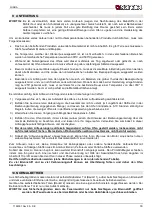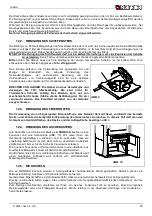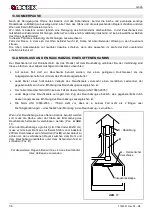
GIADA
7196001 Rev.05 – EN
21
6. CONNECTION TO THE CHIMNEY
For safety reasons the door of the appliances with constructive system 1, must be opened only for the loading of the
fuel or for removing the ashes, while during the operation and the rest, the door of the hearth must remain closed.
The appliances with constructive system 2 must be connected to their own flue. The operating with open door is
allowed under supervision. The connection pipe to the flue must be the shortest possible, right, tight and according to
the current regulations.
The connection to the chimney must be performed with stable and strong pipes (we recommend a thickness of 2
mm). The pipe for smokes exhaust must be fixed hermetically to the chimney. The diameter inside the connection
pipe must correspond to the external diameter of the smokes exhaust small trunk of the stove. This is ensured by
pipes according to DIN 1298.
ATTENTION:
Eventual flammable pieces in the area of 20 cm round the connection pipes must be changed with
fireproof and not sensitive to heat materials.
For a good operation of the equipment it is essential that in the installation place it is introduced sufficient air for
combustion (see chapter 7).
The depression on the chimney (draught) should be 12 Pa (=1.2 mm of water column). The measurement must be
done always with the equipment hot (rating calorific value). When the depression exceeds 17 PA (1.7 mm of water
column) it is necessary to reduce the same with the installation of an additional flue adjuster (butterfly valve) on the
exhaust pipe or in the chimney.
For safety reasons the door of the hearth may be opened only during the loading of fuel. The hearth must remain
closed during the operation and the periods of non use.
7. AIR ENTRANCE INTO THE INSTALLATION PLACE DURING THE COMBUSTION
As the stoves take their combustion air from the installation place, it is essential that a sufficient quantity of air is
introduced in the installation room itself.
In case of tight doors and windows (for example houses built according to the energy saving criteria) it is possible that
the air entrance is not guaranteed, compromising the draught, the welfare and the security of the people. It is
necessary to guarantee a further air entrance through an external air intake, to be positioned in the nearby of the
appliance or through air connection towards outside or a near ventilated room,
with the exception of thermal units
place or garages (FORBIDDEN).
The connection pipe must be flat with a minimum diameter of 120 mm, a maximum length of 4 m and with no more
than 3 bends. If there is a direct connection with the outside it must be endowed with a special windbreak.
The air entrance for combustion into the installation place must not be closed during the operation of the stove. It is
absolutely necessary that in the environment in which the stoves operate with the natural flue of the chimney, it is
introduced as much air as necessary for the combustion, i.e. up to 20 m
3
/hour.
The natural recirculation of air must be ensured by some fixed openings on the outside. The size of the necessary
openings for air is fixed by the relevant prescriptions. Ask information to your chimney sweeper. The openings should
be protected with grids and should never be obstructed.
An extraction hood (aspirating) installed in the same room or in a room
nearby, causes depression with output of combusted gasses (smoke,
smell) even if the hearth door closed. As consequence a contemporary
operation of the hoods is not possible.
The depression in an extraction hood can at worst hypothesis,
transforms the flue into an external air intake, by sucking the
smokes of the rooms with dangerous consequences for the people.
OPTIONAL
For a better comfort and corresponding oxygenation of environment, the
stove combustion air can be directly withdrawn at the outside. In order to
do that, the stove can be connected to the external air socket by an
optional junction (
Picture 8
- A) (Kit Ø 120 ).
Picture 8
A
















































